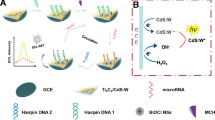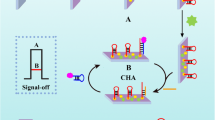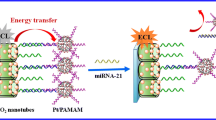Abstract
An efficient electrogenerated chemiluminescence (ECL) nanoprobe (luminol-Au NPs-Ti3C2) was constructed based on Ti3C2Tx MXene (Ti3C2)-mediated in situ formation of Au NPs and anchoring luminol to fabricate a sensitive ECL biosensor for miRNA-155 detection. Herein, Ti3C2 with rich Ti vacancy defects was used as reducing agent, and Au NPs were generated in situ and anchored on the Ti3C2 (Au NPs-Ti3C2). Moreover, the Au NPs-Ti3C2 composites were used as a carrier and provided a large number of sites for the efficient linking of luminol through Au–N bonds to form stable luminol-Au NPs-Ti3C2. The immobilization of ECL emitters is a versatile strategy which not only shortens the electron transmission distance between luminol and electrode, but also provides naked catalytic predominated (111) facets of Au NPs with high electrocatalytic activity, significantly improving the ECL signal of luminol. Furthermore, a catalytic hairpin assembly (CHA) reaction was used, resulting in further amplification of the signal. As a result, the as-prepared ECL biosensor exhibited a linear range from 0.3 fM to 1 nM with a detection limit of 0.15 fM, and demonstrated high reliability of miRNA-155 detection even in human serum samples. The construction of a multifunctional ECL probe with excellent ECL emission opens a new chapter for the application of Ti3C2 in the field of bioanalysis.
Graphical abstract

Herein, Au NPs were generated in situ and anchored on the Ti3C2 (Au NPs-Ti3C2). Moreover, the Au NPs-Ti3C2 was used as a carrier and linked luminol through Au–N bonds to form a stable luminol-Au NPs-Ti3C2 nanoprobe. The strategy displayed versatility which not only shortened the electron transmission distance between luminol and the electrode, but also provided a catalytic surface with high electrocatalytic activity of Au NPs that significantly improved the ECL signal of luminol.






Similar content being viewed by others
References
Li L, Chen Y, Zhu JJ. Recent advances in electrochemiluminescence analysis. Anal Chem. 2017;89:358–71.
Ma C, Cao Y, Gou X, Zhu JJ. Recent progress in electrochemiluminescence sensing and imaging. Anal Chem. 2020;92:431–54.
Zhang S, Liu Y. Recent progress of novel electrochemiluminescence nanoprobes and their analytical applications. Front Chem. 2020;8:626243.
Fan Z, Yao B, Ding Y, Zhao J, Xie M, Zhang K. Entropy-driven amplified electrochemiluminescence biosensor for RdRp gene of SARS-CoV-2 detection with self-assembled DNA tetrahedron scaffolds. Biosens Bioelectron. 2021;178:113015.
Liu PF, Zhao KR, Liu ZJ, Wang L, Ye SY, Liang GX. Cas12a-based electrochemiluminescence biosensor for target amplification-free DNA detection. Biosens Bioelectron. 2021;176:112954.
Nasrollahpour H, Mahdipour M, Isildak I, Rashidi MR, Naseri A, Khalilzadeh B. A highly sensitive electrochemiluminescence cytosensor for detection of SKBR-3 cells as metastatic breast cancer cell line: a constructive phase in early and precise diagnosis. Biosens Bioelectron. 2021;178:113023.
Zhang K, Fan Z, Ya B, Ding Y, Zhao J, Xie M, Pan J. Exploring the tans-cleavage activity of CRISPR-Cas12a for the development of a Mxene based electrochemiluminescence biosensor for the detection of Siglec-5. Biosens Bioelectron. 2021;178:113019.
Zhu L, Yu L, Ye J, Yan M, Peng Y, Huang J, Yang X. A ratiometric electrochemiluminescence strategy based on two-dimensional nanomaterial-nucleic acid interactions for biosensing and logic gates operation. Biosens Bioelectron. 2021;178:113022.
Gan X, Han D, Wang J, Liu P, Li X, Zheng Q, Yan Y. A highly sensitive electrochemiluminescence immunosensor for h-FABP determination based on selfe-nhanced luminophore coupled with ultrathin 2D nickel metal-organic framework nanosheets. Biosens Bioelectron. 2021;171.
Sornambigai M, Venkateswara Raju C, Senthil KS. Bimodal electrogenerated chemiluminescence of the luminol/dicyclohexylamine (DCHA) system: a novel and highly sensitive detection of DCHA via ECL-flow injection analysis. Anal Chem. 2021;93:6472–80.
Xiao SY, Zhen SJ, Huang CZ, Li YF. Ultrasensitive ratiometric electrochemiluminescence for detecting AtxA miRNA using luminol-encapsulated liposome as effectively amplified signal labels. Biosens Bioelectron. 2021;186:113263.
Zhang G, Chai H, Tian M, Zhu S, Qu L, Zhang X. Zirconium-metalloporphyrin frameworks-luminol competitive electrochemiluminescence for ratiometric detection of polynucleotide kinase activity. Anal Chem. 2020;92:7354–62.
Zhu X, Liu H, Dai Y, Wang X, Luo C, Wei Q. Enhanced electrochemiluminescence of luminol based on Cu2O-au heterostructure enabled multiple-amplification strategy. Biosens Bioelectron. 2020;151.
Bertoncello P, Forster RJ. Nanostructured materials for electrochemiluminescence (ECL)-based detection methods: recent advances and future perspectives. Biosens Bioelectron. 2009;24:3191–200.
Zhu X, Zhang Y, Liu M, Liu Y. 2D titanium carbide MXenes as emerging optical biosensing platforms. Biosens Bioelectron. 2021;171:112730.
Li Z, Zhuang T, Dong J, Wang L, Xia J, Wang H, Cui X, Wang Z. Sonochemical fabrication of inorganic nanoparticles for applications in catalysis. Ultrason Sonochem. 2021;71:105384.
Sun J, Sun H, Liang Z. Nanomaterials in electrochemiluminescence sensors. ChemElectroChem. 2017;4:1651–62.
Bertoncello P. Nanomaterials for biosensing with electrochemiluminescence (ECL) detection. Frontiers in bioscience-landmark. 2011;16:1064–108.
Li Z, Dong J, Zhang H, Zhang Y, Wang H, Cui X, Wang Z. Sonochemical catalysis as a unique strategy for the fabrication of nano−/micro-structured inorganics. Nanoscale Adv. 2021;3:41–72.
Khan MS, Zhu W, Ali A, Ahmad SM, Li X, Yang L, Wang Y, Wang H, Wei Q. Electrochemiluminescent immunosensor for prostate specific antigen based upon luminol functionalized platinum nanoparticles loaded on graphene. Anal Biochem. 2019;566:50–7.
Wang S, Wang M, Li C, Li H, Ge C, Zhang X, Jin Y. A highly sensitive and stable electrochemiluminescence immunosensor for alpha-fetoprotein detection based on lumi-nol-AgNPs@co/Ni-MOF nanosheet microflowers. Sens Actuators B Chem. 2020;311:127919.
Naguib M, Kurtoglu M, Presser V, Lu J, Niu J, Heon M, Hultman L, Gogotsi Y, Barsoum MW. Two-dimensional nanocrystals produced by exfoliation of Ti3AlC2. Adv Mater. 2011;23:4248–53.
D, Chen C, Lu G, Song H. Ti3C2 MXene quantum dots/TiO2 inverse opal heterojunction electrode platform for superior photoelectrochemical biosensing. Sens. Actuators B Chem. 2019; 289: 131–137.
Fatima U, Tahir MB, Sagir M, Fatima N. Nawaz T. Ashraf N. Two-dimensional materials and synthesis, energy storage, utilization, and conversion applications of two-dimensional MXene materials. Int. J. Energy Res: Bhatti MP; 2021.
Liu Y, Yu J, Guo D, Li Z, Su Y. Ti3C2Tx MXene/graphene nanocomposites: synthesis and application in electrochemical energy storage. J Alloys Compd. 2020;815.
Riazi H, Nemani SK, Grady MC, Anasori B, So-roush M. Ti3C2MXene-polymer nanocomposites and their applications. J Mater Chem A. 2021;9:8051–98.
Tang R, Xiong S, Gong D, Deng Y, Wang Y, Su L, Ding C, Yang L, Liao C. Ti3C2 2D MXene: recent progress and perspectives in photocatalysis. ACS Appl Mater Interfaces. 2020;12:56663–80.
Zhang H, Wang Z, Zhang Q, Wang F, Liu Y. Ti3C2 MXenes nanosheets catalyzed highly efficient electrogenerated chemiluminescence biosensor for the detection of exosomes. Biosens Bioelectron. 2019;124-125:184–90.
Zhang H, Wang Z, Wang F, Zhang Y, Wang H, Liu Y. Ti3C2 MXene mediated prussian blue in situ hybridization and electrochemical signal amplification for the detection of exosomes. Talanta. 2021;224:121879.
Zhao D, Chen Z, Yang W, Liu S, Zhang X, Yu Y, Cheong WC, Zheng L, Ren F, Ying G, Cao X, Wang D, Peng Q, Wang G, Chen C. MXene (Ti3C2) vacancy confined single-atom catalyst for efficient functionalization of CO2. J Am Chem Soc. 2019;141:4086–93.
Jiang Y, Zhang X, Pei L, Yue S, Ma L, Zhou L, Huang Z, He Y, Gao J. Silver nanoparticles modified two-dimensional transition metal carbides as nanocarriers to fabricate acetycholinesterase-based electrochemical biosensor. Chem Eng J. 2018;339:547–56.
Hui X, Zhao R, Zhang P, Li C, Wang C, Yin L. Low-temperature reduction strategy synthesized Si/Ti3C2 MXene composite anodes for high-performance Li-ion batteries. Adv Energy Mater. 2019;9.
Naguib M, Mochalin VN, Barsoum MW, Gogotsi Y. 25th anniversary article: MXenes: a new family of two-dimensional materials. Adv Mater. 2014;2:992–1005.
Fang Y, Yang X, Chen T, Xu G, Liu M, Liu J, Xu Y. Two-dimensional titanium carbide (MXene)-based solid-state electrochemiluminescent sensor for label-free single-nucleotide mismatch discrimination in human urine. Sens. Actuators B Chem. 2018;263:400–7.
Halim J, Kota S, Lukatskaya MR, Naguib M, Zhao MQ, Moon EJ, Pitock J, Nanda J, May SJ, Gogotsi Y, Bar-soum MW. Synthesis and characterization of 2D molybdenum carbide (MXene). Adv Funct Mater. 2016;26:3118–27.
Nie Y, Yuan X, Zhang P, Chai YQ, Yuan R. Versatile and ultrasensitive electrochemiluminescence biosensor for biomarker detection based on nonenzymatic amplification and aptamer-triggered emitter release. Anal Chem. 2019;91:3452–8.
Yao LY, Yang F, Liang WB, Hu GB, Yang Y, Huang W, Yuan R, Xiao DR. Ruthenium complex doped metal-organic nanoplate with high electrochemiluminescent intensity and stability for ultrasensitive assay of mucin 1. Sens. Actuators B Chem. 2019;292:105–10.
Zhang H, Wang Z, Wang F, Zhang Y, Wang H, Liu Y. In situ formation of gold nanoparticles decorated Ti3C2 MXenes nanoprobe for highly sensitive electrogenerated chemiluminescence detection of exosomes and their surface proteins. Anal Chem. 2020;92:5546–53.
Shahsavar K, Shokri E, Hosseini M. A fluorescence readout method for miRNA-155 detection with double-hairpin molecular beacon based on quadruplex DNA structure. Microchem J. 2020;158:105277.
Cai W, Xie S, Tang Y, Chai Y, Yuan R, Zhang J. A label-free electrochemical biosensor for microRNA detection based on catalytic hairpin assembly and in situ formation of molybdophosphate. Talanta. 2017;163:65–71.
Zeng K, Li H, Peng Y. Gold nanoparticle enhanced surface plasmon resonance imaging of microRNA-155 using a functional nucleic acid-based amplification machine. Microchim Acta. 2017;184:2637–44.
Wang F, Fu C, Huang C, Li N, Wang Y, Ge S, Yu J. Paper-based closed Au-bipolar electrode electrochemiluminescence sensing platform for the detection of miRNA-155. Biosens. Bioelectron. 2020; 150: 111917.
Wang F, Liu Y, Fu C, Li N, Du M, Zhang L, Ge S, Yu J. Paper-based bipolar electrode electrochemiluminescence platform for detection of multiple miRNAs. Anal Chem. 2021;93:1702–8.
Acknowledgements
This work was financially supported by the Taishan Scholar Program of Shandong Province (ts201511027) and the Natural Science Foundation of Shandong Province (ZR2020MB063), China.
Author information
Authors and Affiliations
Contributions
Tingting Zhuang: Data curation, Writing – original draft, Investigation, Drafted and revised the manuscript. Huixin Zhang: Methodology, Writing – review & editing, Investigation, Design. Lun Wang: Characterization, Writing – review & editing. Linhan Yu: Routine analysis. Zonghua Wang: Methodology, Writing – review & editing, Supervision, Funding acquisition. All authors discussed the results and contributed to the writing of this manuscript. All authors have given approval to the final version of the manuscript. Tingting Zhuang and Huixin Zhang contributed equally to this work.
Corresponding author
Ethics declarations
The authors declare that there is no conflict of interest.
The human serum samples used in this work were obtained from the hospital (The Affiliated Hospital of Qingdao University, Qingdao, China), and the ethics committee of the hospital approved the study.
Additional information
Publisher’s note
Springer Nature remains neutral with regard to jurisdictional claims in published maps and institutional affiliations.
Supplementary Information
ESM 1
(DOC 2.74 mb)
Rights and permissions
About this article
Cite this article
Zhuang, T., Zhang, H., Wang, L. et al. Anchoring luminol based on Ti3C2-mediated in situ formation of Au NPs for construction of an efficient probe for miRNA electrogenerated chemiluminescence detection. Anal Bioanal Chem 413, 6963–6971 (2021). https://doi.org/10.1007/s00216-021-03651-7
Received:
Revised:
Accepted:
Published:
Issue Date:
DOI: https://doi.org/10.1007/s00216-021-03651-7




